Chapter 4 Using the SunVTS CDE User Interface
This chapter describes how to run a test session using the SunVTS CDE UI. The procedures are written in a step-by-step form so you can use them to become familiar with SunVTS using the SunVTS CDE UI. This chapter is divided into the following sections:
Note -
This chapter assumes that you have already performed the following procedures: o Installed SunVTS as described in Chapter 2, Installing and Removing SunVTS, o Started SunVTS as described in Chapter 3, Starting SunVTS, o Prepared your system for testing as described in "Preparing Devices for Testing".
See Appendix A, SunVTS Window and Dialog Box Reference for descriptions of each SunVTS window and dialog box.
Getting Started with the SunVTS CDE UI
This section describes how to use the fundamental features of the SunVTS CDE UI to perform diagnostic testing on a system. For information about using more advanced features, see "Using Additional Features with the SunVTS CDE UI".
The SunVTS CDE UI Main Window
When you start the SunVTS CDE user interface, the SunVTS CDE main window is displayed (Figure 4-1). SunVTS is in an idle state with all testing options set to default values.
The procedures in this chapter explain how to use the CDE main window:
Figure 4-1 SunVTS CDE Main Window

Note -
See Appendix A, SunVTS Window and Dialog Box Reference for details about each main window item.
To Configure SunVTS for a Test Session
-
Identify the current state of SunVTS in the Status panel (Figure 4-2).
Figure 4-2 CDE Status panel

The following information is displayed in the Status panel:
-
Testing status--provides the following status of SunVTS:
-
Replay--a previously recorded test session is displayed
-
Stopping--is momentarily displayed when a test session stops
-
Testing--a test session is running
-
-
System passes--displays the total number of successful system passes (a system pass is when all tests have been run once).
-
Elapsed test time--indicates the total number of hours, minutes, and seconds that elapsed during testing.
-
Last Option File--displays the name of the last option file that was accessed.
-
AC Coverage--displays the type of Auto Configuration coverage level that was selected (either confidence, comprehensive, or no_coverage when the AC feature is not in use).
-
-
Select a test mode from the Test Mode panel (Figure 4-3):
Figure 4-3 CDE Test Mode Panel

-
Connection test mode--provides a low-stress, quick testing of the availability and connectivity of selected devices. These tests are non-intrusive, meaning they will release the devices after a quick test, and they will not place a heavy load on system activity.
-
Functional test mode--provides more robust testing of your system and devices. It will use your system resources for thorough testing and it assumes that no other applications are running.
-
Auto Config mode--opens the Automatic Configuration dialog box which provides access to the Automatic Configuration feature. The Automatic Configuration feature simplifies the test session configuration by assigning a predetermined set of test options. See "Using the Automatic Configuration Feature" for instructions on using this feature.
Note -As you change test modes, the tests that are selectable in the System Map change.
-
-
Specify the System Map display mode (logical or physical):
Figure 4-4 CDE System Map (Logical View, Collapsed)

The devices that SunVTS identified as testable devices on your system are listed in the System Map (Figure 4-6). You control the way that SunVTS displays these devices by selecting one of the following:
-
Logical Mapping--organizes the devices, according to their function, into groups. For example, SCSI disk, SCSI tape, and SCSI CD-ROM drives are placed in the SCSI-Devices group. You can focus your testing on a specific device, device group, or on all of the groups on the system.
-
Physical Mapping--shows the exact location of each device on the system in relation to how the devices are connected to each other. If you are testing a single-board type system, each device is shown under the system board. Multi-board type systems show each device under the board (for example, board0, board1, and so on) to which the device is attached. For example, if you have multiple disk drives connected to different disk interfaces, each disk would be displayed under the respective interface. From Physical Mapping, you can determine the actual location of each device. When possible, the board number and controller type for the device are also displayed.
Figure 4-5 Logical and Physical Mapping Examples
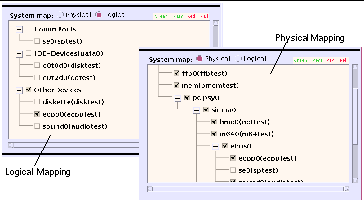
How to do it:
Select the Physical or Logical button.
-
-
Expand the System Map to view selectable devices.
Figure 4-6 CDE System Map (Logical View, Expanded)

About devices in the System Map:
When SunVTS is started, most of the devices in the System Map are collapsed, meaning individual devices are grouped together and hidden from view under a device category. A "+" (plus) indicates that the device group is collapsed. A "-" (minus) indicates that the device group is expanded so you see each device for a given category.
How to do it:
Use the following methods to open the System Map:
-
Click on the "+" next to a specific group in the System Map to expand an individual group.
-
-
Select the devices that you want to test.
Figure 4-7 Devices Selected in the System Map
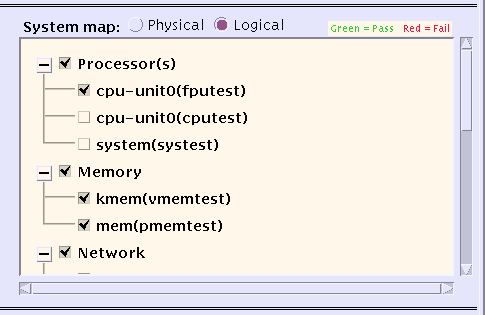
A checkmark next to a device in the System Map indicates that device is selected. Depending on the devices on your system, and the test mode that you select, SunVTS selects certain devices by default.
How to do it:
-
Select your devices using the buttons in the Device Selection panel:
-
None--deselects all devices
-
All--selects all devices
Note -Any device that requires your intervention before the test can run (such as loading media for tape, CD-ROM, and diskette tests), also requires that you notify SunVTS that you have performed this action by selecting the Intervention checkbox. You cannot select any intervention mode tests until you select this checkbox.
-
-
Refine the selected devices by clicking on the checkmark box next to a device or device group.
-
-
Modify the system-level test options (if desired).
SunVTS is ready to test each device once you select it. There are, however, testing options that you can modify that alter the way tests run to suit your testing needs. There are three levels where you control test options:
-
System-level options--control the testing attributes of all devices. This is the highest level, applying all your options globally. When you modify options at this level, the option settings are propagated down to the group-level and device-level options.
-
Group-level options--control the testing attributes of all the devices in the group. Settings made at this level propagate down, setting all the options in the levels in the group.
-
Device-level options--control the testing of a single, specific device. Some of these options can also be applied to the other like-devices with Apply to All pull-down menus.
The order that you apply the system-level, group-level, and device-level options is important. Start by assigning the system-level options, then assign the group-level options, and finish with the device-level options. Otherwise, if you make lower-level option settings, then higher level option settings, the higher-level settings will propagate down and undo your lower-level settings. An alternative to this approach is to use locks and overrides to protect lower level settings. See "Preserving Test Options with Locks and Overrides".
Note -System-level, group-level, and device-level options are only available when Functional Test Mode is selected. Most of these options are grayed-out and not available for Connection Mode testing.
Figure 4-8 Options from the Menu Bar
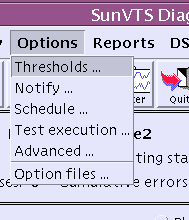
How to do it:
Access the system-level options from the Options menu in the Menu Bar (Figure 4-8).
The following dialog boxes provide system-level options that define how the entire test session runs.
-
Thresholds--provides access to test session limits such as the maximum number of system passes and the maximum test session time.
-
Notify--provides access to set up testing notification through email.
-
Schedule--provides access to auto start, single pass, and concurrency options.
-
Test Execution Options--allows you to define how a test session runs. For example, you can select stress mode which enables the most rigorous testing. You can set the Max errors value to define the maximum number of allowable errors before stopping the test (0=continue to run on infinite errors).
-
Advanced--provides overrides and locks that control which option settings (system-level, group-level, or device-level) take precedence.
Note -These dialog boxes are described in detail in Appendix A, SunVTS Window and Dialog Box Reference.
Note -To increase or decrease a numeric value in a SunVTS CDE dialog box, you can either use the up or down arrows, or type a new value in the text box and press Return. Press Apply to apply all dialog box changes.
-
-
Modify group-level and device-level options (if desired).
Figure 4-9 Test-Specific Options
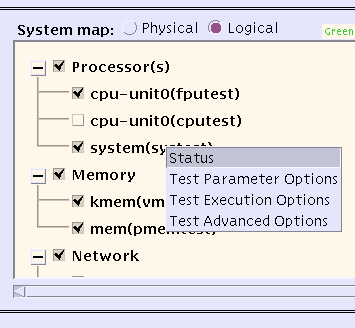
About group-level and device-level options:
Group-level and device-level options are testing attributes that accompany each test and pertain to a specific device (or device group) only.
How to do it:
Access the group-level and device-level menus by placing your pointer over a device (or device-group) and right-clicking on it.
A menu appears offering access to the following dialog boxes (Figure 4-9):
-
Status--displays a list showing each test instance and a test pass and fail value for each instance.
-
Test Parameter Options--Shows device configuration information and provides the controls for defining specific test options. This menu is different for each kind of test. For example, the Test Parameter Options for the memory test (pmemtest) allow you to specify the amount of memory to test, while the network test (nettest) provides a setting to define a target host for test packets. Refer to the SunVTS 5.0 Test Reference Manual for descriptions of all the Test Parameter Options. Once you change a Test Parameter Option, apply the change to the desired level:
-
Within Instance--applies the option settings to this test instance (test instance 1 for example) with:
o Apply to Group--to all the same instances, of this device type, in the group.
o Apply to All--to all the same instances of the same device type on the system.
-
Across All Instances--applies the option settings to all test instances (for example, instance 1 and 2) with:
o Apply--for all test instances for this device.
o Apply to Group--for all test instances for the same device type in the group.
o Apply to All--for all test instances for the same device type on the system.
See "Test Parameter" for more information.
-
-
Test Execution Options--allows you to define how a test runs. For example, you can select stress mode which enables the most rigorous testing. You can set the Max errors value to define the maximum number of allowable errors before stopping the test (0=continue to run on infinite errors). The options in this menu are the same for each kind of test.
-
Test Advanced Options--Provides a setting to "lock" the option settings for an individual device so that the system level setting will not affect the option setting for this test. See "Preserving Test Options with Locks and Overrides" for more details.
-
Schedule Options (group level only)--sets the maximum number of tests you want to run at the same time in the same group.
Note -For descriptions of the options presented in these dialog boxes see, "SunVTS Dialog Boxes".
-
To Run, Monitor, and Stop a Test Session
-
Start the test session by clicking on the Start Button.
Depending on how you configured the options in the Test Execution menus, testing will continue until:
-
a test error is detected (this is the default behavior). If you enter a value for Run On Error, SunVTS continues to run until the specified number of errors is reached.
-
testing has reached the Max Passes value. The default is to run indefinite test passes. When individual test passes are complete, SunVTS continues to display the status testing for 5 seconds. If you do not select additional devices to test in the 5 second interval, SunVTS enters an idle state.
-
testing has reached the Max Time value. The default is to run indefinitely.
-
you select the Stop button.
-
-
Monitor the overall test session status by watching the Status panel.
The Status panel indicates that a test session is running by displaying testing for the Testing status. The system passes, cumulative errors, and elapsed test time will increment.
-
Monitor specific tests by watching the System Map.
-
An asterisk--displayed next to each device indicating the device that is currently under test. Depending on how you configured SunVTS (with the System Concurrency option), single or multiple devices are tested concurrently.
-
-
Check for test messages by watching the Test Message panel.
The Test Message panel displays test messages under the following circumstances:
-
When a test error occurs.
-
If you enable trace mode (from the Commands->Trace test menu bar selection) and set the trace to display in the window, all of the test system calls are displayed.
-
-
Stop the test session (if desired) by clicking the Stop button.
To Review and Reset Test Session Results
-
SunVTS provides access to four log files:
-
SunVTS test error log--contains time-stamped SunVTS test error messages. The log file pathname is /var/opt/SUNWvts/logs/sunvts.err. This file is not created until a SunVTS test failure occurs.
-
SunVTS kernel error log--contains time-stamped SunVTS kernel and SunVTS probe errors. SunVTS kernel errors are errors that relate to running SunVTS, and not to testing of devices. The log file pathname is /var/opt/SUNWvts/logs/vtsk.err. This file is not created until SunVTS reports a SunVTS kernel error.
-
SunVTS information log--contains informative messages that are generated when you start and stop SunVTS test sessions. The log file pathname is /var/opt/SUNWvts/logs/sunvts.info. This file is not created until a SunVTS test session runs.
-
Solaris system message log--is a log of all the general Solaris events logged by syslogd. The pathname of this log file is /var/adm/messages.
How to do it:
-
The Log file window is displayed.
-
Specify the log file that you want to view by selecting it from the top button in the Log file window.
The content of the selected log file is displayed in the window.
-
With the three lower buttons you can:
-
Delete the log file--the file remains displayed, but will be gone the next time you try to display it.
Note -Take the length of the log file into consideration before you print it.
-
-
-
Interpret SunVTS messages
There are many messages for each of the many tests that run under SunVTS. For this reason, it is difficult to document the implication of each message that you might see. Most messages contain all the explanatory text that is possible for each event that is encountered. Some messages are information messages (INFO, VERBOSE, WARNING) which do not represent an error, and some messages are error messages (ERROR and FATAL), indicating that the test detected a failure. This section explains generic test message information.
SunVTS information message example:
04/24/00 17:19:47 systemA SunVTS5.0: VTSID 34 disktest.VERBOSE c0t0d0: "number of blocks 3629760"
SunVTS error message example:
05/02/00 10:49:43 systemA SunVTS5.0: VTSID 8040 disktest. FATAL diskette: "Failed get_volmgr_name()" Probable_Cause(s): (1)No floppy disk in drive Recommended_Action(s): (1)Check the floppy drive
Whenever possible, the error message supplies a message type (Table 4-1), followed by the message text, one or more probable causes, and one or more recommended corrective actions.
The following table describes the types of messages you might encounter. All messages are displayed in the Message panel, and most are logged in one of the SunVTS logs (Info or Error).
Table 4-1 Message TypesMessage Type
Log file
Description
INFO
Info log
Displayed when a non-error test event occurs.
ERROR
Error and Info logs
Displayed when a test detects an error, often an indication of a problem with a specific function or feature of the device under test.
FATAL
Error and Info logs
Displayed when a test detects a severe error that might cause the test to exit; such as a failure to open a device. These errors are indicative of hardware failures.
VERBOSE
Not logged
Test progression messages that are displayed when the verbose feature is enabled.
WARNING
Info log
Displayed when something affects the test that is not an error; such as a device that is busy.
You can write scripts that watch for certain SunVTS events as they are logged in the log files, and which trigger an action when a particular message string occurs. If you plan to do this, refer to the following SunVTS message syntax and descriptions (Table 4-2).
SunVTS Message Syntax
: Table 4-2 SunVTS Message Syntax Descriptions
<timestamp> <hostname> "SunVTS<version_id>:" [VTSID <vts_msgid> <modulename>[.<submodulename>][.<instnum>][(#P)].<vts_msgtype>] [<device_pathname>:] <msg_text>
Message Item
Descriptions
<timestamp>
Represents the date in mm/dd/yy format, and the time in hh:mm:ss format, when the message was logged.
<hostname>
Name of the system under test.
SunVTS<version_id>
Displays the string SunVTS followed by the version of SunVTS, for example SunVTS5.0.
VTSID <vts_msgid>
Displays the string VTSID followed by the ID of the message.
<modulename>
Name of the module (usually the test name or vtsk) that generated the message.
<submodulename>
Name of the subtest, if applicable.
<instnum>
Number of the test instance.
(#P)
Processor ID for which the test is bound (applicable if a test is assigned to a specific processor with the processor affinity option).
<vts_msgtype>
Identifies the message with one of the following message types: ERROR, FATAL, INFO, VERBOSE, or WARNING.
<device_pathname>
Name of the device under test.
<msg_text>
The text of the message. This often includes the error, a probable cause, and a recommended action.
Note -The message syntax changed as of SunVTS 4.0. For the old message syntax information, see Appendix B, Frequently Asked Questions. In a future version of SunVTS, the old message format will no longer be supported. Update any scripts that rely on the old message format.
-
Reset the test session results (if desired).
When you are done reviewing the information in the main window, you can clear the current results by clicking on the Reset button. This resets the information in the Status panel. This does not reset your test options.
Using Additional Features with the SunVTS CDE UI
This section describes additional SunVTS features using the SunVTS CDE user interface:
Using the Automatic Configuration Feature
The Automatic Configuration feature simplifies the SunVTS configuration steps by automatically assigning a predetermined set of test options. This feature provides the following benefits:
-
Consistent testing--as you test the system from time to time, you know that the same test options are applied. You also get diagnostic consistency when you test multiple systems of the same platform type.
-
Reliable testing--provides assurance that any errors that you might encounter are not due to incorrectly set test options.
-
Simplified configuration--there are many options for the numerous SunVTS tests. The Automatic Configuration feature takes the guesswork out of assigning these options.
-
Time Saving--You can select the Automatic Configuration feature without manually setting the options and start testing right away.
To Use the Automatic Configuration Feature
-
Prepare any "intervention" devices and select the Intervention checkbox.
-
Select Auto Config from the Select Test Mode panel.
The Automatic Configuration dialog box is displayed (Figure 4-10).
-
Select one of the following choices from the Automatic Configuration dialog box:
-
Comprehensive--sets all the test options for thorough testing. All applicable functional tests are enabled. The test session validates the full functionality of the system and provides you with assurance that the system is hardware fault free.
-
Confidence--sets all the test options such that there is limited functional test coverage as compared to the Comprehensive level of coverage. The Confidence level testing verifies the main functionality of the system in a shorter amount of time.
Figure 4-10 Automatic Configuration Dialog Box
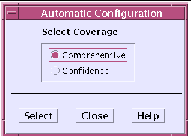
Note -The Help button displays a dialog box with Auto Configuration information and instructions.
-
-
Click on Select in the dialog box.
SunVTS applies the predefined options and is ready to test selected devices.
-
(Optional) Select or deselect the devices that you want to test in the System Map.
This step is optional. For full system testing, use the devices that are selected by the Automatic Configuration feature.
-
Click the Start button in the SunVTS main window.
The test session runs with the predetermined set of options based on the level of coverage (comprehensive or confidence) that you selected. The AC Coverage (Confidence or Comprehensive) is displayed in the Status panel.
Connecting to Another Host
You can connect the SunVTS user interface on your local system to a SunVTS kernel that is running on another system in your network. Once you are connected to the remote system, all of the controls in the CDE UI control the testing of the remote system.
To Connect to Another Host
-
Make sure that the SunVTS kernel is running on the remote system.
You can do this in several ways. You can remote login (using rlogin or telnet) to the remote system and run the vtsk command.
Note -On the remote system, you must login (or switch user) as a user that has SunVTS privileges (superuser by default) before you can start the SunVTS kernel (vtsk).
Note -You can only connect to a system running the same version of SunVTS.
-
On the local system (the system running the SunVTS UI), click on the Connect to Host button.
The Connect to Host dialog box is displayed.
-
Specify the name of the remote system to which you want to connect.
Enter the hostname in the Connect to Host field. As you connect to various remote systems, SunVTS keeps track of those systems and displays them in the Hostname List. You can reconnect to one of those hosts by double-clicking on the host name in this list. This list is only maintained during your current SunVTS session. When you quit SunVTS, the Hostname List is cleared.
Any number of UIs can connect to a SunVTS kernel and each UI displays a synchronous view of SunVTS.
-
Click Apply in the Connect to Host dialog box.
The SunVTS UI now controls the SunVTS testing of the remote system. The remote system hostname is displayed in the Status panel, confirming the connection.
Using the Email Notification Feature
You can have SunVTS send the test status messages to you using email.
To Enable Email Notification
-
Select Notify from the Options menu in the Menu bar.
The Notify Options dialog box is displayed.
-
Select one of the following from the Send Email pull-down menu:
-
disabled--disables the email notification feature.
-
now--send email immediately one time, then disable the notification feature.
-
on error--send email when an error occurs.
-
periodically--send email at regular intervals as specified in the Log Period.
-
on_error&periodically--send email periodically and when an error occurs.
-
-
Enter an email address in the email address field.
-
If you selected Periodically or on_error&periodically, specify the log period in minutes (1-99999).
-
Click on Apply.
You will receive the SunVTS information messages in email based on your notification criterion.
Controlling the Size of the Log Files
The log file sizes of the SunVTS test error log (/var/opt/SUNWvts/logs/sunvts.err), the SunVTS kernel error log (/var/opt/SUNWvts/logs/vtsk.err) and the information log (/var/opt/SUNWvts/logs/sunvts.info) are each limited to a maximum size of 1 Mbyte by default. When the log file reaches the maximum size, the content is moved to a file called logfilename.backup. Additional events are added to the main log files. If the log file reaches the maximum size again, the content is moved to the backup file, overwriting the earlier backup file content. Only one backup file is maintained for each log file.
You can modify the log file maximum size specification.
To Modify the Log File Size Limits
-
Select Option->Thresholds from the Menu bar.
The Threshold Option dialog box is displayed.
-
Use the arrows to increase the Max System Log Size number.
Select a number from 1 to 5 (Mbytes). For example, if you choose 5 Mbytes, SunVTS will use up to 30 Mbytes for log files (there are three log files, each may also have an equal sized backup file).
-
Click on Apply.
Tracing a Test
You can use the Trace test option to create a log of every system call made when a test is running. This feature logs the system calls using the standard UNIX command truss. The trace messages logged by this feature give you a powerful debugging tool for isolating the specific cause of an error.
To Enable Tracing
-
Select Commands->Trace test from the Menu bar.
The Trace Test window is displayed.
-
Choose a test to trace from the list of test names and then select Apply, or double-click a test name to enable tracing and close the window.
When you select a test, system call tracing is enabled immediately. If the test is already running when you select it, tracing begins immediately and the trace test messages appear in the SunVTS console window.
Note -You can only select one test at a time to trace when using the SunVTS CDE user interface.
Note -When using the Physical map view, you can only see one level in the hierarchy (such as one controller on a system board). Therefore, some devices that are several levels down are not available to trace. Use the Logical view to select tracing for these devices.
-
Select File and click Apply to write the trace test messages to a file called /var/opt/SUNWvts/logs/sunvts.trace.
To Disable Tracing
-
Bring up the Trace Test window again, click on the highlighted test name, and click Apply.
This action deselects the test and disables tracing.
Preserving Test Options with Locks and Overrides
With locks and overrides you can preserve or override the options you set at the system level, group-level, and device-level (see Step 6).
Locks
Normally, when you change an option setting at the system level or group-level, the new option setting propagates down to all lower levels. Enabling the lock prevents an option setting made at a higher level from affecting the lower-level option setting.
Note -
The override option nullifies lower-level locks.
To Set (or Unset) a Lock
-
Open the Test Advanced Options dialog box from the group-level or device-level you want to lock.
To access this dialog box, place your pointer over the group or device and right-click. Then select Test Advanced Options from the menu.
-
Click the Enable button to set the lock (or disable button to unset the lock).
With the lock set, you can make option setting changes at higher levels without affecting the option settings of the locked device.
Overrides
You can use overrides to void the lock protection. Setting the system-level override nullifies all locks, and setting a group-level override nullifies all the locks below that group.
To Set (or Unset) an Override
-
Open the Advanced Option dialog box at one of the following levels:
-
System level--select Option->Advanced from the Menu bar.
-
Group level--place your pointer over the group and right-click. Then select Test Advanced Options.
-
-
Enable the Override setting (or disable the Override setting to unset it).
-
Click Apply.
Scaling Your Test Session
You can use a combination of options to scale (increase or decrease testing intensity) to meet your diagnostic needs. For example, you can modify test options so that each test instance runs simultaneously, thus increasing the stress level for a single or multiprocessor system. The following procedures can be used individually or in combination to scale the test session.
To Modify the Number of Test Instances
You can scale your test session by running multiple copies of the same test on your devices. Each copy is call a test instance. Each test instance is a separate process of the same test. The number of test instances can be set at the system level, group level, and the device level as follows:
-
Open the Test Execution dialog box at one of the following levels:
-
Group level--place your pointer over the group and right-click. Then select Test Execution Options.
-
Device level--place your pointer over the device and right-click. Then select Test Execution Options.
-
-
Use the arrow buttons to increase or decrease the number of instances.
-
Click Apply.
To Modify Test Concurrency Options
The test concurrency option sets the number of tests that run at a given time during a test session. You can set this value to one to run one test at a time, or increase the test concurrency value thus increasing the stress level of your test session.
There are two options in the Schedule Option dialog boxes (at the system level and group level) to scale your test session:
-
System Concurrency--sets the maximum number of tests that you can run at the same time at the system level. It overrides the Group Concurrency option.
-
Group Concurrency--sets the maximum number of tests to run simultaneously in the same group. This option is available at the system level and the group level.
-
Open the Schedule dialog box from one of the following levels:
-
System level--select Option->Schedule from the Menu bar.
-
Group-level--place your pointer over the group and right-click. Then select Schedule Options.
-
-
Use the arrow buttons to increase or decrease the System Concurrency and Group Concurrency values.
-
Click Apply.
To Bind a Test to a Processor with the Processor Affinity Option (for Multiprocessor Systems)
By default, the Solaris kernel assigns each test instance to whichever processor is available at the time. On multiprocessor systems, you can bind (assign) a test instance to a particular processor as follows:
-
Open the Test Execution dialog box at one of the following levels:
-
System level--select Option->Test Execution from the Menu bar.
-
Group-level--place your pointer over the group and right-click. Then select Test Execution Options.
-
Device-level--place your pointer over the device and right-click. Then select Test Execution Options.
Note -The Processor Affinity field is only displayed on multiprocessor systems.
Note -The Processor Affinity option is not available for processor tests such as cputest and fputest. These tests are associated with each individual processor on your system and you cannot bind these tests to a different processor.
-
-
Select a Processor from the Processor Affinity field.
-
Click Apply.
Using the Debugging Features
You can enable certain options that cause the SunVTS test session to output more test data than when you run the session with the default option values. The following procedures describe how to enable these features.
To Enable (or Disable) Verbose and Core File Options
-
Open the Test Execution dialog box at one of the following levels:
-
System level--select Option->Test Execution from the Menu bar.
-
Group-level--place your pointer over the group and right-click. Then select Test Execution Options.
-
Device-level--place your pointer over the device and right-click. Then select Test Execution Options.
-
-
Enable (or disable) one or more of the following options:
-
Verbose--displays verbose messages indicating when the test is starting and stopping during the test session.
-
Core File--when enabled, creates a core file when a test session results in a core dump. The core file is called sunvts_install_dir/bin/core.testname.xxxxxx , where testname is the test that dumped the core, and xxxxxx is a character string generated by the system in order to make the file name unique.
Note -The Trace feature also provides additional test data. See "Tracing a Test".
-
Saving a Test Session Configuration for Repeated Use (Option Files)
You can use the Option Files feature to save the current set of selected devices and test options for reuse. This is a convenient feature when you plan to the same test session configuration over and over again.
The configuration information is saved in a filename of your choice in the /var/opt/SUNWvts/options directory.
Note -
Do not manually edit any option file. Unnecessary or spurious characters in the option file can cause unexpected behavior when you use it.
To Create an Option File
-
Configure SunVTS for the test session that you want to save.
-
Select Options->Option files from the Menu bar.
The Option Files dialog box is displayed.
-
Specify an option file name in the Option File field.
-
Click on Store.
-
Repeat Step 1 through Step 4 for each test session configuration you want to save.
-
Click Close in the Option Files dialog box.
The Option Files dialog box is closed, and your test session configurations are saved for future use.
To Load an Option File
Note -
Loading an option file that was created on another system is permitted, but you must make sure that the configuration is valid for the system you plan to test.
Note -
Do not load an option file that was created in a 64-bit environment into a 32-bit environment.
-
Select Options->Option files from the Menu bar.
The Options Files dialog box is displayed.
-
Select an option file from the Option file list.
-
Click Load.
The test session configuration is loaded into SunVTS and the name of the option file is displayed in the Status panel. You can use this configuration, or modify it before you start the test session.
To Remove an Option File
-
Select Options->Option files from the Menu bar.
-
Select the option file that you want to delete from the Option File List.
-
Click Remove.
-
Click Close.
Using the Auto-Start Feature
You can use the auto-start feature, along with saved option files, to simplify the process of configuring a test session and running it.
To Configure SunVTS to use the Auto-Start Feature
-
Select Options->Schedule from the Menu bar.
The Schedule dialog box is displayed.
-
Enable the Auto Start setting in the Schedule dialog box.
-
Create an option file as described in "To Create an Option File".
The option file that you create is configured to use the auto-start feature.
To Use the Auto-Start Feature
-
Select Commands->Quit SunVTS->UI and Kernel.
You must quit SunVTS and restart it for the auto-start feature to work.
-
Use the following command to restart SunVTS from the command-line, specifying the option file that you created:
# /opt/SUNWvts/bin/sunvts -o option_file
SunVTS displays the main window and automatically starts the test session.
Suspending and Resuming a Test Session
You can suspend a test session while it is running. For example, you might want to look at messages on the Message panel that have scrolled out of view, or you may want to view and print a log file.
To Suspend and Resume a Test Session
-
Select Commands->Suspend from the Menu bar.
"Suspended" is displayed in the Status panel, and the test session pauses until you resume it.
-
Select Commands->Resume from the Menu bar.
"Testing" is displayed in the Status panel, and the SunVTS kernel resumes the suspended test session.
Recording and Replaying a Test Session
You can use the Record and Replay feature to record a SunVTS test session. Only one test session recording is saved at a time.
The events are recorded in a file called /var/opt/SUNWvts/vts_replay_file.
Once a test session is recorded, you can use the recorded events to drive the SunVTS kernel so it reproduces the recorded sequence of events at a later time.
Note -
The Record and Replay feature closely reproduces the sequence of events, but it cannot reproduce the time periods of these events because the execution times vary from one run to another.
Note -
Do not edit the /var/opt/SUNWvts/vts_replay_file.
To Record and Replay a Test Session
-
Configure SunVTS for the test session that you want to run.
-
Select Commands->Start testing with record from the Menu bar.
The test session runs, and the events are recorded. When testing stops, the recorded session is available to replay.
-
Select Commands->Replay to replay the test session.
The kernel reruns the same tests, with the same configuration that you specified in Step 1.
Note -During the replay, the kernel is actually rerunning the tests, not just re-displaying the recorded session.
Scheduling Test Sequences With the Deterministic Scheduler
SunVTS provides a Deterministic Scheduler that you can use to define what tests run and in what order. If you do not use this feature, selected tests run in an order that is determined by SunVTS.
Deterministic Scheduler Overview
The Deterministic Scheduler is available as a dialog box from the SunVTS CDE interface menu-bar area.
The following list provides an overview of the steps you perform to start, run, and quit the Deterministic Scheduler feature. Detailed instructions follow.
-
Start SunVTS with the SunVTS CDE user interface.
-
Start the Deterministic Scheduler.
-
Create one or more tasks. A task is a SunVTS test session configuration (one or more selected SunVTS tests, test options, and specified test mode).
-
Create the sequence. A sequence is a group of tasks specified to run in a certain order.
-
Start the sequence.
-
When the sequence is done, reset the Deterministic Scheduler if desired.
-
Quit the Deterministic Scheduler feature.
Getting Started With the Deterministic Scheduler
-
Start SunVTS with the SunVTS CDE user interface as described in Chapter 3, Starting SunVTS.
-
Start the Deterministic Scheduler by selecting DSched->start DS from the SunVTS menu bar.
The Deterministic Scheduler Dialog box is displayed (Figure 4-11).
Note -When you start the Deterministic Scheduler, many of the commands from the main SunVTS window such as Start, Stop, Resume, Suspend, Record, Replay, Load, and Set are not permitted. When you stop the Deterministic Scheduler, these SunVTS features become functional.
Note -The Help button displays a dialog box with Deterministic Scheduler information and instructions.
Figure 4-11 Deterministic Scheduler Dialog Box
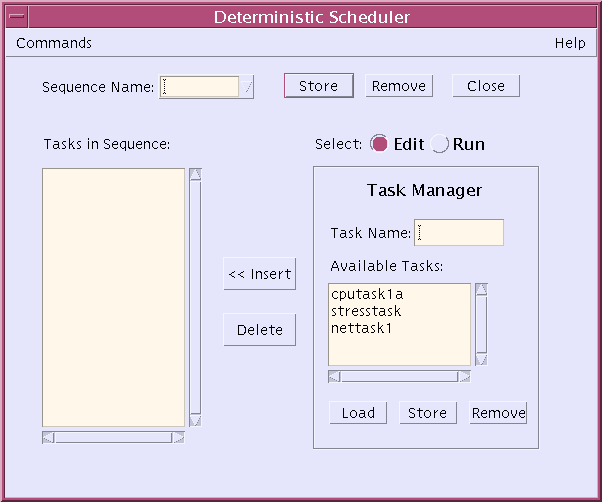
-
Define your task(s) as described below:
-
In the Deterministic Scheduler dialog box, click on the Edit button.
The Deterministic Scheduler displays the Task Manager panel and shows a list of existing tasks (if any have been created) in the Available Tasks list. You can use existing tasks or create new tasks. If this is the first time that the Deterministic Scheduler is used, you must create your own.
-
In the SunVTS main window, configure a test session (select one or more devices and your desired test mode).
If you assign more than one test to a task, the order of the tests within this task will be determined by SunVTS. If you want to control the order of every test, assign only one test for each task.
When the Deterministic Scheduler is started, it changes the default values of Max System Passes from 0 (run indefinitely) to 1 (run one pass). This is necessary so that each task only runs selected tests once and proceeds to run subsequent tasks in the sequence.
-
In the Deterministic Scheduler dialog box, enter a task name.
-
Click on Store in the Task Manager panel.
Your task appears in the Available Task list.
Figure 4-12 Tasks Defined in the Task Manager Panel
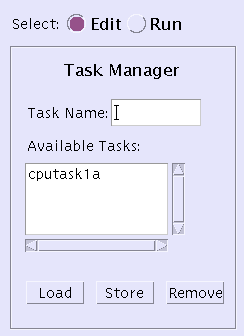
-
To see the tests configured for a particular task, select the task from the Available task list and press Load.
The SunVTS main window shows the SunVTS test configuration that is associated with the selected task.
-
If you want to modify a task: select it; load it; change the test configuration in the SunVTS main window; and press Store in the Task Manager panel.
-
If you want to delete a task, select it and press Remove in the Task Manager panel.
The task is removed from the Available Task list.
-
-
Define the sequence as follows:
-
Select a task from the task list.
-
Press the Insert button.
The task is added to the sequence list.
-
Repeat the previous steps until all desired tasks are added to the sequence list in the order that you want them to run.
You can add the same task more than once.
When you begin testing, the tasks run from the top of the list down.
-
If you want to remove a task from the sequence list, select it and press Delete.
-
To save the sequence for future use, enter a name in the Sequence name field and press Store in the Task Manager panel.
The sequence will be saved for easy retrieval for future testing.
Figure 4-13 Deterministic Scheduler Dialog Box
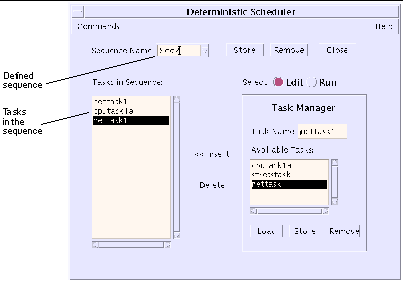
-
With the Sequence selected, press the Run button.
The right-hand panel displays the Sequence Runner panel (Figure 4-14), providing access for you to define the number of times (loops) for the sequence to run and to start running the sequence.
Figure 4-14 Sequence Runner Panel
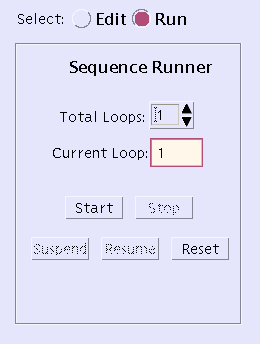
-
-
Press the Start button to start the sequence.
While testing is underway you can:
-
monitor the test progress in the main SunVTS window. All test results are logged in the SunVTS log files.
-
close the Deterministic Scheduler dialog box by pressing the close button or by selecting Commands->Quit Options->Quit UI only from the Deterministic Scheduler dialog box. Testing will continue, and results will be displayed in the SunVTS main window. You can reopen the Deterministic Scheduler dialog box from the SunVTS main window.
-
suspend and resume the sequence by pressing the suspend and resume buttons in the Deterministic Scheduler dialog box.
-
-
Use the Reset button to reset the SunVTS main window and the Deterministic Scheduler.
The SunVTS main window test statistics and the Deterministic Scheduler current loop count are reset.
-
Quit the Deterministic Scheduler when you are done by selecting Commands->Quit Options->Quit DS and UI.
The Deterministic Scheduler and the Deterministic Scheduler dialog box are dismissed.
- © 2010, Oracle Corporation and/or its affiliates
